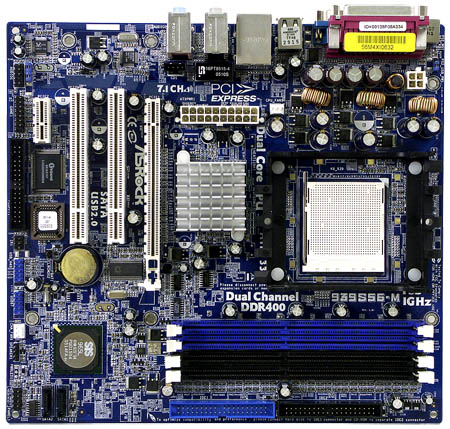 |
||
|
||
| ||
We haven't reviewed ASRock motherboards for a long time. And today
we have an opportunity to test another budget model from this manufacturer.
ASRock 939S56-M is equipped with a chipset from SiS (SiS756), this
fact means that the product price should be low. It should be noted
right away that unlike the previously reviewed ASRock
K8 Combo-Z and ASRock
K8Upgrade-760GX, this motherboard does not feature any original
technologies and designs, it's just a work horse for a mass consumer.
We have an impression that the designers intended to create a solution
as cheap as possible but still modern. Socket 939 combined with PCI
Express must arouse interest of common home users. At the same time,
939S56-M peripheral capacities are minimal: it uses the most unassuming
(among modern SiS solutions) Southbridge and is limited by its features.
Additional controllers include cheap PHY controllers from Realtek
for the network and audio controllers of the southbridge, but the
audio codec supports 8 channels instead of 6 ones. The number of expansion
slots and peripheral connectors does not boggle imagination either:
two PCI slots, one PCIEx1 and just two SATA slots are insufficient
for these times. However, there are four memory slots instead of only
two, which is important for many users.  As appears from the above, the PCB layout is rather convenient, despite the miniature microATX board dimensions. Regular full-sized models have an FDD connector near the bottom (it's left on the photo) edge, which may hamper the connection in high towers, but in this case the cable is certainly long enough. However, there are still some drawbacks: we would note a relatively high Northbridge heatsink, which is so close to the processor socket that it interferes with the cooler installation; it may even make it impossible to install a cooler with an expanding heatsink. We can also note the location of both power connectors on a motherboard near the rear panel, so that their cables will overhang the processor cooler. Access to one of the jumpers is hampered when a motherboard is installed into a PC case. There are no jumper descriptions on the PCB, but there are tips for users instead :) The 3-phase switching voltage regulator of the processor incorporates six 3300 uF capacitors and four 1200 uF ones. The board also contains a voltage regulator for memory consisting of six 1000 uF capacitors. In general, critical circuits incorporate electrolytic capacitors from OST (we are not very enthusiastic about it) and United Chemi-Con. There are no empty seats on the motherboard, which is only natural considering that the 939S56-M is the only ASRock model for Socket 939 based on the SiS756 chipset. Motherboard dimensions — 244x224 mm (slightly smaller than the standard microATX, six-screw mount, one edge sags a little). System monitoring (Winbond W83697HF, according to BIOS Setup)
Onboard ports, sockets, and connectors
Back panel (left to right, blockwise) Click the image to open the rear view of this motherboard
Package Contents
Integrated Controllers
The integrated audio quality was tested in 16bit, 44 kHz using the RightMark Audio Analyzer 5.5 test application and the Terratec DMX 6fire sound card:
General performance: Good (Details). Proprietary technologies and peculiarities
Settings
We used BIOS 1.00; later versions, available at the time of this review, just added microcodes of the new processors. The mentioned BIOS parameters are available in this version, but the viability of non-standard settings hasn't been tested. PerformanceTestbed configurations:
As the ASRock 939S56-M is the first model on SiS756 that we tested, we cannot
possibly compare its results with other representatives of the chipset.
But as we remember well that the performance of motherboards for AMD64
does not depend on a chipset (to be more exact, only periphery and,
perhaps, video card's performance), we can safely compare our today's
budget model and the top motherboard ECS
KN1 Extreme on nForce4 Ultra.
As you can see, the two motherboards on absolutely different chipsets demonstrated very close results in 2D. It's only natural, considering that this ASRock motherboard allows to choose DRAM Timing mode and specify all main memory timings in BIOS Setup. As we already mentioned before, nForce4 chipsets behave strangely when working with 3D graphics, but the results in this case are similar anyway. Having experimented with additional memory parameters (listed in the table above), we noted a performance drop triggered by disabling Bank Interleaving and enabling Flexibility Option (we haven't determined what this option really does), while changing Burst Length had no effect on the results. Note that we carried out these express tests only in synthetic (stress) RMMA test, so real applications may act differently. To sum it all up, the ASRock 939S56-M motherboard proved itself a fast model with some modern features, unassuming functionality and bundle. In return, this model comes at an extremely low price. No doubts, this product will be very popular.
This model on the manufacturer's web site (Russian mirror) The motherboard is kindly provided by the manufacturer
Write a comment below. No registration needed!
|
Platform · Video · Multimedia · Mobile · Other || About us & Privacy policy · Twitter · Facebook Copyright © Byrds Research & Publishing, Ltd., 1997–2011. All rights reserved. | |||||||||||||||||||||||||||||||||||||||||||||||||||||||||||||||||||||||||||||||||||||||||||||||||||||||||||||||||||||||||||||||||